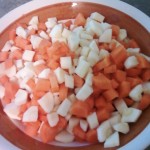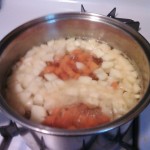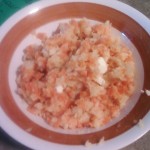This Meatless Monday, we feature parsnips, with growing, storage and prep tips, as well as recipes for Carrot and Parsnip Mash and Parsnip and Cauliflower Soup from Vermont Fresh: A Fruit and Vegetable Handbook.
Background
Parsnips are a root vegetable closely related to carrots, which is not surprising given their striking resemblance. Parsnips, which look like a white, leggy carrot, have been a food source for thousands of years. Once one of Europe’s winter food staples, parsnips fell out of popularity with the introduction of the potato in the Middle Ages. Starchy, nutty, and slightly sweet, parsnips were even grown as a sweetener until the 19th century when they were again replaced by another vegetable, the sugar beet. Parsnips, which are now considered more of a specialty vegetable than a staple in many places, have a unique flavor that verges on slightly spicy. Parsnips grow significantly better in cooler climes and develop the best flavor after several frosts. CAUTION: in rare instances, parsnip leaves can cause burn-like rashes.
Growing Tips
Parsnips like to be grown in deep, rich, loose soil that is free of rocks and weeds. Like carrots, parsnips should be directly seeded and not transplanted. Parsnip seeds do not store well, so it is important to make sure you don’t use old seeds. Sow seeds thickly about ½ inch deep in the soil in mid-spring. Parsnip seeds can take three weeks or more to germinate, so do not be discouraged if you don’t see seedlings right away! Once seedlings have sprouted and are growing steadily, thin out the plants so that each seedling has several inches of room to grow. Weed frequently and water occasionally in dry weather. Harvest only after a hard frost has occurred for the best flavor. Parsnips are difficult to pull up and will probably need to be dug out with a shovel or spading fork. They can usually be left in the ground well into October.
Storage
Parsnips will keep in a plastic bag in the refrigerator for several weeks after harvesting. They can also be stored in a root cellar or another cool place, especially if they are packed in damp sand. To freeze parsnips, remove the tops and scrub roots well. Peel and slice as desired. Steam or blanch parsnips for three minutes, cool, and drain. Pack in freezer bags or containers and freeze.
Nutritional Benefits
Parsnips have high concentrations of Vitamin C, fiber, folic acid, potassium and carbohydrates. Parsnips are a diuretic. They may help with bladder problems, kidney stones, and detoxifying the body.
Preparation
Choose medium-sized, smooth-skinned roots without any obvious soft spots. Larger roots can have tough, woody cores. Before preparing parsnips, scrub them thoroughly, cut off the tops, and peel them if you wish. Young, tender parsnips can be eaten raw in salads, but parsnips are most often cooked. Their flavor can be very intense, so experiment with small quantities.
Meatless Monday Recipe: Carrot and Parsnip Mash
Janice Santiago, a volunteer baking, tasting and testing recipes out of the Vermont Fresh Handbook tried out this recipe. Her comments and adjustments are in italics below the recipe.
Serves 4
(adapted from John Harrison: allotment.org)
Ingredients
- 4 medium carrots
- 4 medium parsnips
- 1 tablespoon butter
- 2 tablespoons milk or cream
- Salt and pepper to taste
Instructions
- Trim any remaining greens off the carrots and parsnips. Scrub them thoroughly and, if the skins are old or tough, peel them if desired.
- Chop the carrots into ½ inch-thick pieces. Do the same with the parsnips.
- Bring a medium pot of water to a boil. Add the carrots and parsnips and boil until soft. If you prefer, you may steam them instead.
- Drain the vegetables. Add the butter and milk or cream, then mash as you would potatoes.
- Add salt and pepper to taste and serve piping hot with additional butter.
Note: Because carrots and parsnips are so sweet, this is a great vegetable dish to try on children! Experiment with different seasonings and herbs for more complex flavors.
From Janice:
“Found loose parsnips for sale at Price Chopper for $2.49 lb – usually buy a bag of them, like a lb bag of carrots, at Hannaford. I looked to find price for comparison, but Hannaford didn’t have a price up for them.
“I would say this took about 45 minutes – mainly because of peeling the veggies and chopping them up.
“I loved this!! It’s a great twist on a mash – and could easily replace potatoes in meals and would be a great side for Thanksgiving dinners.
“Suggestions might be mashing them up with a blender to make more smooth or using a ricer? I don’t use a ricer, but my Mash didn’t come together as creamy as a potato would have – maybe I didn’t cook long enough or I didn’t add enough milk to it. However, I would say after using a potato masher and adding butter, milk, salt and pepper – it’s really good!!
“Other suggestions – taking the cut up veggies and sauteing them in a pan making like a hash with them OR (I like this one better)…taking the Mash and making Mash pancakes and frying up in a pan like a potato pancake!! I might have to try that!!
“I would confirm that yes, it serves about 4 people – 1/2 cup or so each.”
- Photo courtesy of Janice Santiago
- Photo courtesy of Janice Santiago
- Photo courtesy of Janice Santiago
- Photo courtesy of Janice Santiago
Meatless Monday Recipe: Parsnip and Cauliflower Soup
Serves 4-6
(adapted from thursdaynightsmackdown.com)
Ingredients
- 1 small head cauliflower, chopped
- 3 medium parsnips, peeled and chopped
- 3 tablespoons olive oil
- 1 onion, chopped
- 2 tablespoons flour
- 4 cups chicken broth or stock
- Salt and pepper to taste
Instructions
- Preheat oven to 475°. Toss chopped cauliflower and parsnips with 1 tablespoon olive oil, spread in a rimmed baking pan, and roast until veggies are tender, about 30 minutes.
- Meanwhile, sauté onion in 2 tablespoons olive oil in a heavy soup pot over medium heat, cooking until soft. Sprinkle with flour and cook another few minutes, until flour is golden.
- Place roasted veggies in a blender with the broth and process until smooth. Transfer to soup pot with onions and flour and whisk altogether. Reheat mixture and simmer 10 minutes. Add salt and pepper.
- For a smooth soup, process (carefully) in blender again before serving.
To receive more recipes and tips on your favorite fruits and vegetables, download Vermont Fresh: A Fruit and Vegetable Handbook. Vermont Foodbank fresh food initiatives would not be possible without your support. Please consider giving to the Vermont Foodbank today!




